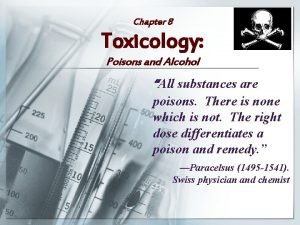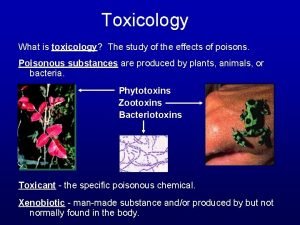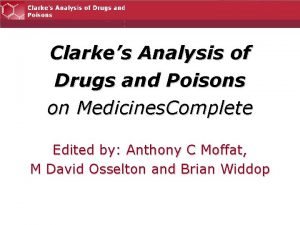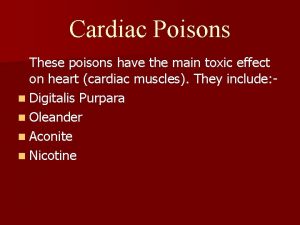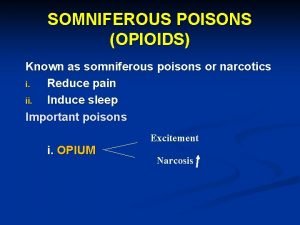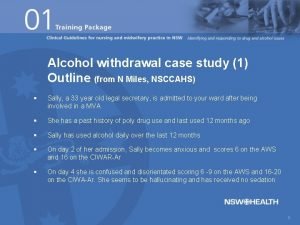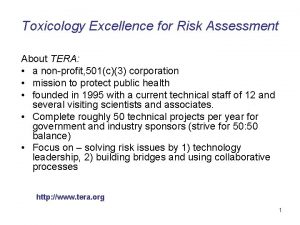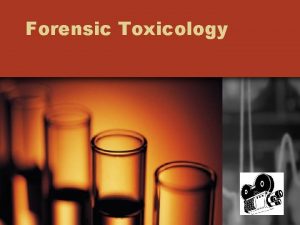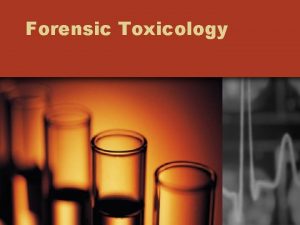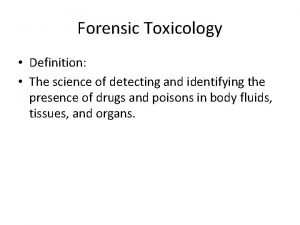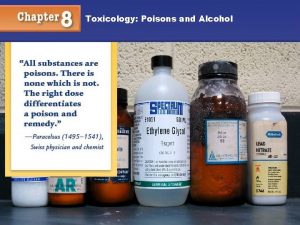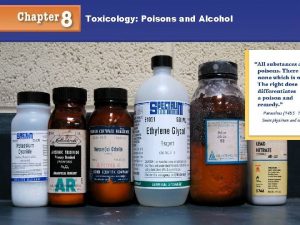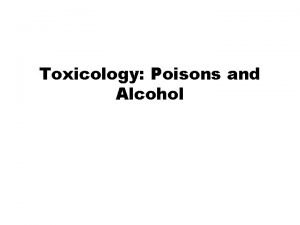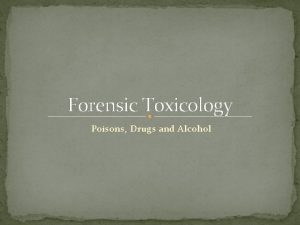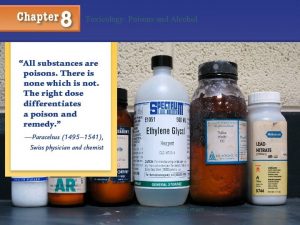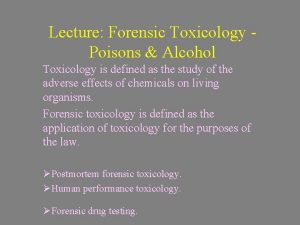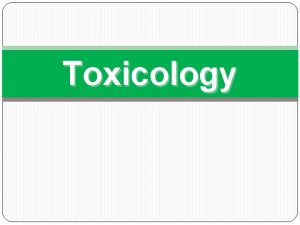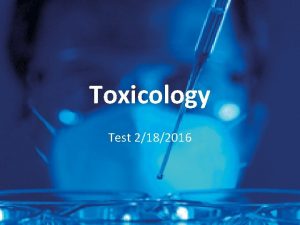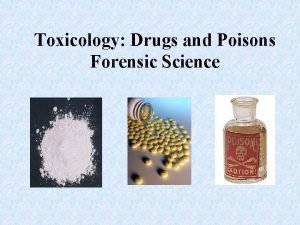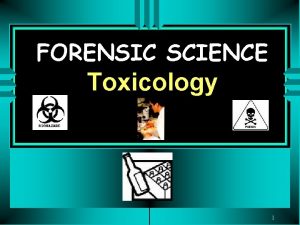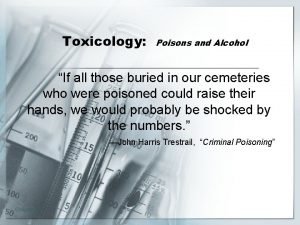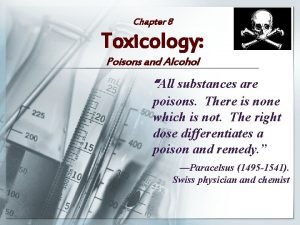Toxicology Poisons and Alcohol Toxicologythe study of the



















- Slides: 19

Toxicology: Poisons and Alcohol

Toxicology—the study of the adverse effects of chemicals or physical agents on living organisms Types: Environmental—air, water, soil Consumer—foods, cosmetics, drugs Medical, clinical, forensic

Forensic Toxicology Postmortem—medical examiner or coroner Criminal—motor vehicle accidents (MVA) Workplace—drug testing Sports—human and animal Environment—industrial, catastrophic, terrorism

Toxic substances may: Be a cause of death Contribute to death Cause impairment Explain behavior

Historical Poisoners Olympias—a famous Greek poisoner Locusta—personal poisoner of Emperor Nero Lucretia Borgia—father was Pope Alexander VI Madame Giulia Toffana—committed over 600 successful poisonings, including two popes • Hieronyma Spara—formed a society to teach women how to murder their husbands • Madame de Brinvilliers and Catherine Deshayes— French poisoners • AND many others through modern times. • •

• Mathieu Orfila—known as the father of forensic toxicology, published in 1814 Traité des poisons which described the first systematic approach to the study of the chemistry and physiological nature of poisons

Aspects of Toxicity 1. Dosage 2. The chemical or physical form of the substance 3. The mode of entry into the body 4. Body weight and physiological conditions of the victim, including age and sex 5. The time period of exposure 6. The presence of other chemicals in the body or in the dose

Lethal Dose LD 50 refers to the dose of a substance that kills half the test population, usually within four hours Expressed in milligrams of substance per kilogram of body weight • Chronic exposure to toxins occur over a long period of time. • Acutely toxic substance occurs immediately.

Toxicity Classification

Federal Regulatory Agencies • • • Food and Drug Administration (FDA) Environmental Protection Agency (EPA) Consumer Product Safety Commission Department of Transportation (DOT) Occupational Safety and Health Administration (OSHA)

Symptoms of Various Types of Poisoning Type of Poison Symptom/Evidence Caustic poison (lye) Characteristic burns around the lips and mouth of victim Carbon monoxide Red or pink patches on the chest and thigh, unusually bright red lividity Sulfuric acid Black vomit Hydrochloric acid Greenish-brown vomit Nitric acid Yellow vomit Phosphorus Coffee-brown vomit, onion or garlic odor Cyanide Burnt almond odor Arsenic, mercury Extreme diarrhea Methyl (wood) or isopropyl (rubbing) alcohol Nausea and vomiting, unconsciousness possibly blindness

Critical Information Form Common color Characteristic odor Solubility Taste Common sources Lethal dose Mechanism Possible methods of administration Time interval of onset of symptoms Symptoms resulting from an acute exposure Symptoms resulting from chronic exposure Disease states mimicked by poisoning Notes relating to the victim Specimens from victim Analytical detection methods Known toxic levels Notes pertinent to analysis of poison List of cases in which poison was used

Human Specimens for Analysis • Blood • Urine • Vitreous humor of eyes • Bile • Gastric contents • Liver tissue • Brain tissue • Kidney tissue • Hair/nails

Alcohol—Ethyl Alcohol (C 2 H 5 OH) • Most abused drug in America • About 40 percent of all traffic deaths are alcohol-related • Toxic—affecting the central nervous system, especially the brain • Colorless liquid, generally diluted in water • Acts as a depressant • Alcohol appears in blood within minutes of consumption; 30– 90 minutes for full absorption • Detoxification—about 90 percent in the liver • About 5 percent is excreted unchanged in breath, perspiration, and urine

Rate of Absorption of Alcohol Depends on: • Amount of alcohol consumed • The alcohol content of • the beverage • Time taken to consume it • Quantity and type of food • present in the stomach • Physiology of the consumer

BAC: Blood Alcohol Content • Expressed as percent weight per volume of blood • Legal limit in all states is 0. 08 percent Parameters influencing BAC: • Body weight • Alcohol content • Number of beverages consumed • Time since consumption

BAC Calculation Burn-off rate of 0. 015 percent per hour, but can vary: Male BAC = Female BAC = 0. 071 (oz) (% alcohol) body weight 0. 085 (oz) (% alcohol) body weight

Field Tests • Preliminary tests—used to determine the degree of suspect’s physical impairment and whether or not another test is justified • Psychophysical tests—three basic tests: • Horizontal gaze nystagmus (HGN): follow a pen or small flashlight, tracking left to right with one’s eyes. In general, wavering at 45 degrees indicates 0. 10 BAC. • Nine-step walk and turn (WAT): comprehend and execute two or more simple instructions at one time • One-leg stand (OLS): maintain balance; comprehend and execute two or more simple instructions at one time

Lead in the environment • • Paint (in homes and old toys or products produced in other countries) X-ray Shielding Old water pipes Residue from lead gasoline
 Chapter 8 toxicology poisons and alcohol
Chapter 8 toxicology poisons and alcohol Chapter 8 toxicology test
Chapter 8 toxicology test Toxicology study
Toxicology study Formation of alcohols
Formation of alcohols Secondary alcohol oxidation
Secondary alcohol oxidation Clarke's analysis of drugs and poisons
Clarke's analysis of drugs and poisons Cardiac poisons example
Cardiac poisons example Somniferous poisons
Somniferous poisons Erythism
Erythism Toxicology and applied pharmacology
Toxicology and applied pharmacology Annual review of pharmacology and toxicology
Annual review of pharmacology and toxicology Food safety and toxicology
Food safety and toxicology Drug identification and toxicology
Drug identification and toxicology Nsccahs
Nsccahs Tera toxicology
Tera toxicology Father of forensic serology
Father of forensic serology Breath tests reflect alcohol concentration in which artery?
Breath tests reflect alcohol concentration in which artery? History of toxicology slideshare
History of toxicology slideshare Forensics toxicology definition
Forensics toxicology definition Environmental toxicology definition
Environmental toxicology definition
